How exciting your ride is, depends on the truck.
In this Longboard truck guide, you’ll discover why a Longboard truck gives the rider more pleasure than any other board.
If you want a strong truck that’s forged with A356 aluminum, and affordable, get the Atlas Truck Reverse Kingpin Longboard Truck on Amazon. It’s the best we’ve found after researching over 50 Longboard trucks and testing more than a dozen.
Our pick
Atlas Truck Reverse Kingpin Longboard Truck on Amazon
Most importantly, your knowledge of a truck will guide your decision when thinking about which one to buy.
That is why this article is written to provide you with useful information about longboard trucks.
Longboard truck has wider space and the ability to make a U-turn. Though every longboard requires two trucks:
- An axle
- A hanger
A longboard is more balanced on the ground compared to standard skateboard trucks.
Riding on a longboard truck is safer than Standard Skateboard trucks.
Longboard trucks have reversed or inverted kingpins. This feature will make it turn faster when riding.
Also, they have softer bushings, which allow easy maneuvering. It has stiffer bushing that stabilizes the longboard at high speeds.
Components Of Longboard Trucks

These are features that make a longboard truck one of the best Skateboards. These features make it unique.
The speed of a longboard truck is controlled by these components. How fast it moves depends on these features.
These features were added to modify it and make it better than the standard skateboard.
Here are the components of longboard trucks:
Axle Width
The axle is the long pin that runs through the hanger and connects to the wheels.
The width of an axle is ranging from 8mm to 10mm. The size makes them different in performance.
Axles of widths 10mm are stronger and heavier — though, with little bearing weight. While 8mm has more bearing weight and is more common. 8mm is considered the best among riders.
Hanger
The larger part of the skateboard truck is the hanger, which supports the axle that runs through it.
It has a triangular shape, and it’s a metal. The width is measured in millimeters.
Hanger width ranges from 100mm to 215mm. This is what determines how wide the wheels track.
Kingpin
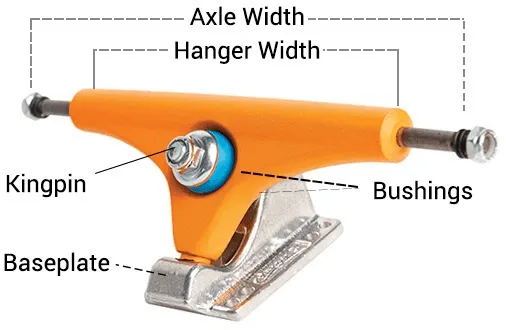
There are two main types of kingpins:
- Traditional Kingpin Truck (TKP).
- Reverse Kingpin Truck (RKP)
The kingpin is the bolt that holds the skate truck’s part inside the bushings.
The hollow kingpin is more durable. This type of kingpin is lighter and is on the rising.
Bushings Seat

Bushings are the rings coated around the kingpin that makes the board turn smoothly. While the bushings seats are the areas of the truck where the bushing sits. The size of the rear where the bushing sits varies from seat to seat.
Baseplate
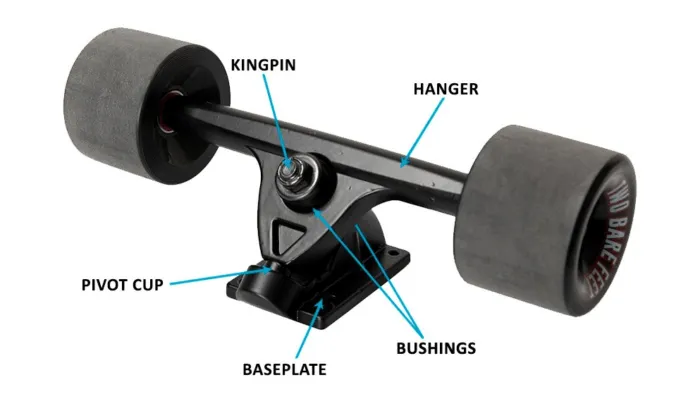
The baseplate is the back of the truck that mounts the plate, which locks the truck assembly to the skateboard deck. It has different angles that change the turning. Let’s look at the baseplate angle.
Baseplate Angle
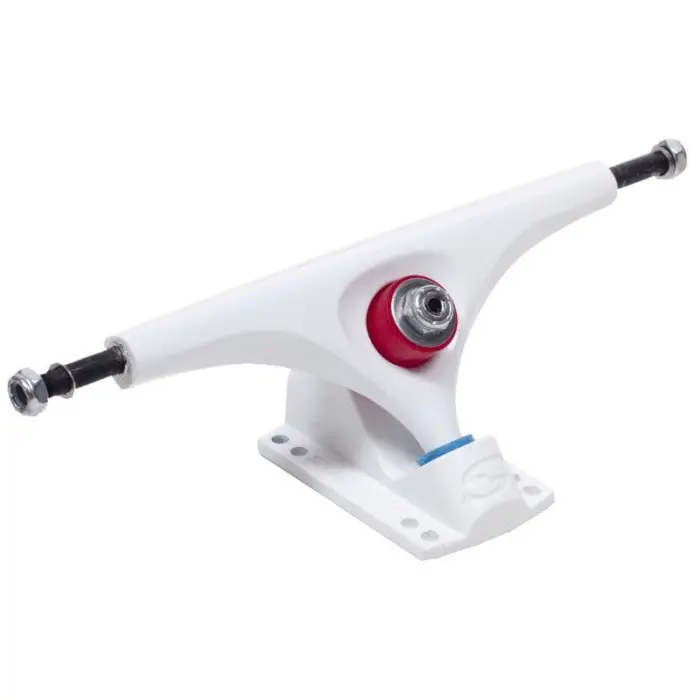
The angle the hanger forms with the pivot cup is called the baseplate angle. It is measured in degree, which ranges from 20 – 70. The most common ones are 30 – 60.
Pivot Cup/Pivot Point
The pivot cup is the round bushing that the hanger rotates inside. It also helps the hanger to turn freely. How free the hanger rotates depends on the pivot cup.
If there is no oil or grease, the rotation will not be easy for the hanger. This will limit the speed.
A pivot point is a pivot that’s used in the truck hanger. There are three types:
- Standard
- Cylinder
- Ball.
This pivot point is what determines how easy the hanger rotates during a turn. It’s like a seat, which the hanger seat upon.
Mounting Holes
These are holes in the baseplate where the hardware is fixed to mount the baseplate to the deck. This comes in traditional and modern patterns.
This is what connects the baseplate and the deck together. Depending on the usage, it can easily become wide or expand. At this point, it will not be able to connect them both.
Then you can change it.
Ride Height
The distance between the ground floor to the truck is called the ride height. The most common height of the truck to the ground floor is 2.3.
The lower one is more stable than, the higher ones.
Construction
Most of the skateboards are made from metal. Manufacturers use mental in such a way that they create tools to shred it into any design of their choice.
There are 3 main types of longboard truck construction:
- Cast
- Forged
- Precision
The table below shows the different types of trucks’ construction longboards.
| Trucks | Price ($) | Durability | Stability |
| Cast Trucks (180mm) | 84.95 | Not | Relatively Stable |
| Precision Trucks(180mm) | 94.99 | Durable | Stable |
| Forced Trucks | 88.99 | High Durable | Highly Stable |
The cast is cheaper, weakest, and imprecise. The precision is stronger than cast and is stronger and bearing. Forged is the strongest among all and has an average level of moderation.
Let’s quickly look at the details of the 3 types of longboard truck construction:
Cast Trucks
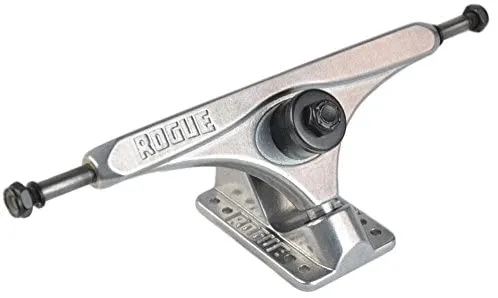
Sometimes, most people prefer cast trucks. Most of the longboard and skateboard trucks are designed from cast aluminum.
The process is to pour the metal into a pre-built mold and allow it dry for some time. Once it solidifies, you have your cast trucks.
Cast trucks are the weakest ones, among other trucks. It’s the least durable among the trucks.
During the construction, the grain of the metal falls into a random circle that makes it weak after mold.
There’s a complete imperfection on the cast truck. It can easily be manipulated into any shape compared to the precision trucks.
The cast trucks also experience bend after being used several times. Also, heavier riders make cast trucks bend as well. The cast trucks are cheaper compared to other trucks.
Precision Trucks
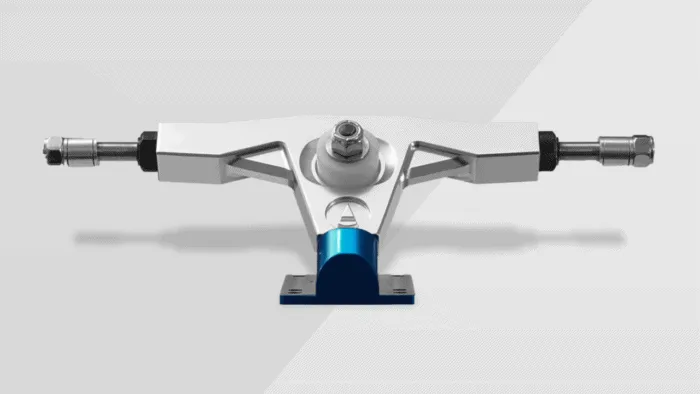
The precision trucks aren’t cast. They’re cut out from a block of aluminum. They’re stronger than the cast.
They use a CNC machine to cut the shape. Because of the CNC machine, its tighter tolerances, and exact shape. Since the shape isn’t bent, it is stronger than the cast.
The precision trucks are stronger than the cast trucks because the shape goes along with the aluminum block where it is cut from.
Another reason is that the aluminum where the precision trucks cut from are stronger than the metal.
One of the reasons why precision trucks are more expensive is because of the CNC machine.
Not just the cost of running a CNC machine is very expensive, but the aluminum block used in making it is expensive as well.
Precision trucks are more beautiful and more durable compared to cast trucks.
They are appealing to the eyes and immaculate in nature. The parts like the bushing, bearing, and hardware work flawlessly without any delay.
Forged Trucks
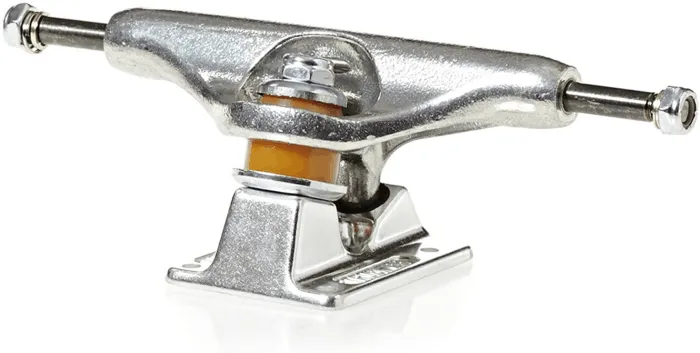
This truck is called a forced truck because the aluminum blocks are forced into the desired shape.
A forged truck is designed with the same aluminum block used in making the precision trucks. The difference is in how they create shapes.
The aluminum blocks are beaten or forced into the required shape, unlike the precision truck where it’s cut into the desired shape by a CNC machine.
The Forced trucks are the strongest among every other truck. More durable and stable.
Because of the beauty of precision trucks are more expensive than forced trucks. But the forced trucks are more expensive than the cast trucks.
Truck Option
Choosing the right truck is based on the type of ride you what. However, the 3 types of trucks are designed to meet your desires.
There are two main types of trucks. The three are different in size and strength. Though the durability and speed are what make the difference as well.
However, anyone you choose to ride on will definitely get the desired pleasure. So, before you make your choice, know the type of ride you want. This will guide your purchase decision.
There are a lot of factors you need to consider when making a choice. Some of these factors are speed limit, durability, ease to turn, control, etc.
These factors are what guide your decision on which truck to ride on. Also the direction it will face plays a major role as well.
The 3 main trucks are as follows:
- Standard kingpin trucks
- Reverse kingpin trucks
- Dual pivot trucks
i). Standard Kingpin Trucks

Standard trucks are mainly for cruising, carving, tech sliding, and parking. The standard kingpin is the most commonly seen Skateboard.
They’re higher and give more control. You may want to use it on high decks because of its maneuverability.
However, this has been designed into longboarding because of its strength. They’re more durable. It doesn’t speed much.
Do you need a truck to move around town? Then consider Standard kingpin trucks. Standard kingpin trucks give you pleasure when you want to move around town.
Standard kingpin trucks are what people commonly use for street and park skateboarding.
This is also nice for smaller longboard cruisers around the street because they have a low ride height. These usually come in smaller sizes.
ii). Reverse Kingpin Trucks
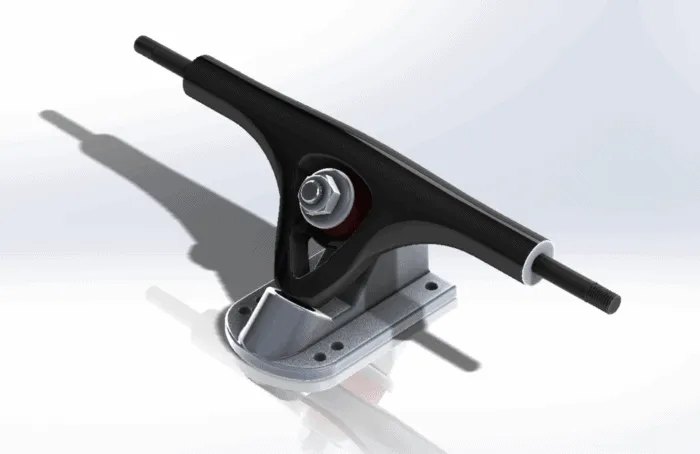
Do you need Skateboard for freestyle, freeride, and downhill? Then go for Reverse kingpin trucks.
Reverse kingpin trucks have all the functions of both dual pivot and standard. It’s like a higher version of a standard kingpin truck.
Reverse kingpin trucks are more lively and steady at low speeds. And the speeds are more stable and easy to control.
They sit more comfortably on the truck board than the Standard kingpin trucks. The setup is preferable compared to other skateboards.
As an inexperienced rider, you feel more comfortable with reverse kingpin trucks than the standard ones.
Reverse kingpin trucks are easy to turn and higher than other skateboards. Riding the opposite of the truck becomes easier because it is designed to have the opposite direction.
Riding becomes easy and flexible with reverse kingpin trucks. Reverse kingpin trucks make you enjoy ridE.
This is designed for both experienced and inexperienced riders. It’s easy to learn with it when you’re inexperienced.
iii). Dual Pivot Trucks
Dual pivot trucks are responsive because of the extra turn. This is higher than any other skateboard.
The experience from the dual-pivot is incomparable to any other one.
Dual pivot trucks are more balanced and easy to control when on speed. It is higher than other skateboards. This makes it have a much higher ride height than others.
The height makes it perform better on slow-speed cruising. Though, it’s not stable on a hill or on long-distance rides.
Dual pivot trucks have higher speeds than any other ones. When riding down the hill, the speed increases more compared to others.
Longboard Truck Size
The size of both longboard trucks and longboard decks is important. They work hand-in-hand. The size of both should be the same. Even though there will be differences, it shouldn’t be much of a difference.
Hence, they’ll not work perfectly well. The longboard truck width should be the same as the longboard deck width. Because when there is a big difference the seating will not be balanced.
When you want to buy, check the difference in the width. To ensure it isn’t much. You may decide to keep the difference to be less than 1/4″, this is quite ok.
However, some of the companies have different sizes of widths. This could make it difficult to choose the close sizes of a longboard. Though, you can ask for the measurement before you finalize the transaction.
Every brand of longboard width is measured in inches. Since you know what is used to measure it, you can then go ahead and measure it by yourself. This will help you to easily match your truck boards to the deck.
It’s advisable to always go for a wider track. They’re stable but less responsive. A wider truck will give you a better ride and freestyle.
The most common trucks for downhill are 180mm in size and they’re good for freeriding.
When you’re thinking of transportation go for size 150mm trucks. They are excellent for transportation and carving.
Longboard Truck Bushing Seats
The longboard truck bushing seats are where the hanger sits. This provides space and regulates the truck’s energy to turn because it serves as lubricating oil.
The bushing is what controls the speed limit. How fast the truck is, sometimes depends on the condition of the bushings.
If the bushing is faulty, you find it difficult for the truck to move faster. Though, you might exert force on it to move; it will not get to speed because the bushing is not good.
Ensure your bushing is good before you ride on. How speed is your truck depends on how good your bushing is, because that is what regulates the turn of the truck.
The tight bushing seat comfortably controls or moderates the turn of the trucks and protects the bushings.
The bushing makes it more stable for high speeds. Though, it lacks responsiveness at slower speeds.
An unrestrictive bushing seat gives room for quick turns. This also requires minimal effort to carve. These unrestrictive bushing seats are good for freestyling and carving rides.
Most importantly, some trucks are more versatile because they’re bent in shape in the middle. Because of this shape, they can easily be customized.
Irrespective of your bushing seat, you can customize your truck. Make the shape of your truck look exactly how you want it.
You can go for any bushings setup that will work well for your riding. The bushing is more or less like the engine of the truck. So, once it sizes your truck, you can ride on.
Baseplate Angle
What changes the ride most is the baseplate. Experienced riders know how important baseplate angles are. This is what controls the speed.
The top truck brands usually offer two types of trucks. These two are 40 degrees and 50 degrees.
Choosing any of these to ride on has more advantages. Invariably, you will have a nice excitement when you ride on any of the two.
You can use the 40-ish degree baseplate both freeride and downhill. It’s easy to turn at any point. Both experience and inexperience can ride it.
The 40-ish degree baseplate can easily turn freeride and downhill — that’s the reason the inexperienced one enjoys it most. It’s one of the best to learn from.
The 40-ish is more balanced and secure when you are riding down the hill. Most importantly, the riders have confidence in the wheel.
It has a good wheel to ride on. Because of the wheel, it’s more secure and safe. They are found to be high-performance, fast freeride, and easy to use.
The 50-ish degree is the higher version. It’s higher than the 40-ish degree. It’s freer to ride on than the 40-ish.
Turning when riding on 50-ish becomes easier. Though inexperienced one doesn’t easily enjoy riding on a 50-ish degree.
You enjoy a 50-ish degree when you have experience. So it’s for a more advanced one — rather it’s advantageous to experience riders.
Those who ride at high speeds prefer 50-ish degrees. Because it has more speed than 40-ish degrees, it’s freer and speeds up.
When you ride on the 50-ish degree, you get more excitement than the 40-ish degree. You can easily turn it into a slide with 50-ish degrees. You are safer and more secure with a 50-ish degree compared to a 40-ish degree.
When you take a 50-ish degree on a downhill ride you have more pleasure. Feel relaxed and have more free control over it than the 40-ish truck.
The 50-ish degree has more pleasure than a 40-ish degree. That is why they are more popular than the 40-ish degree.
For those who aren’t experienced yet, when they learn with a 50-ish degree, they become more experts in riding.
Those who learn with 50-ish find it easier to drive the 40-ish. It’s preferable when you want to learn, use the 50-ish to start.
Ride Height
The ride height is the distance from the bottom of the plate to the middle of the truck axle. Or the height of the base plate to the middle of the truck axle.
For you to get the exact measure of ride height, begin your measure from the middle of the truck axle.
This will give the precise ride height. This measurement is applicable to all the truck board designs.
Though, sometimes there is a change in actual ride height due to a change in the deck design ( dropped through, dropped deck). So the ride heights aren’t the same at all times.
The speed, and stability change alongside the ride height of a skateboard truck.
Any change to occur or take place on the ride height changes the speed and stability.
The higher the truck sits, the more unstable it will be with speed. Likewise the lower the ride height, the more stable it will be with speed also.
What determines the stability of the truck is the ride height. If you need a stable truck when on speed, go for the low one.
Below are the benefits you get from a higher setup:
- There is a hookup that makes wheels regain traction easily and faster
- You can easily fit larger wheels
- Running a truck loser becomes easy
- Low stability at speed
- High speed
- Less control
- Make cruise enjoyable on the downhill
- Difficult to push and footbrake
The benefits of a low ride height:
- High stability at speed
- Higher control
- Easier to push and footbrake
- Easy to predict and controllable slide
- Possess a greater risk of wheel bite
- The trucks need to be run tighter
- Low turning “feel”
- Less pleasure on the downhill
Those who can control the speed go for the downhill. Even though there’s a lack of control at the high speed.
Experienced riders still go downhill to ride at high speed. Because they have the experience to control the speed.
The experienced rider has spent so much time gaining their experience, so, handling the speed becomes simple to them.
The ability and advantage to control the speed limit outweigh the disadvantage.
The higher hook-ups and increased turns are more appreciated by the experienced rider. How you control this depends on your experience.
So is good to good on it first before you take it downhill. The skat is in your control when you know how to control it. You enjoy it more when you know how to ride.
Split Degree Truck Setups
A split-angle setup makes downhill rides more enjoyable. That’s why riders prefer the split-degree truck setup.
The split-degree truck setups are where a lower-degree baseplate is used on the back of the truck.
For example, this is when a 50-degree back truck with a 40-degree front truck.
This setup will make the skate nice, nice and responsive in the back while keeping you balanced in the front to avoid front truck steering, which is the cause of loosening control over speed.
Or the 40-degree truck is with a 50-degree front truck. This type of setup is also good and responsive in the front while making you stable in the back.
Once it balances you the possibility of steering oot from the speed is minimal.
Rake
One of the features of trucks that control the ratio between turn and lean is called the rake.
Or rake is defined as the power offset or the amount of axle offset from the center of hanger rotation, which is measured in millimeters (+ / -).
Though, the rake doesn’t change the rotation of the hanger (the baseplate degree of the truck).
Rake only changes the location of the wheels relative to the axle of rotation. But it has nothing to do with the rotation just as said before.
The rake also controls the rate the truck dive into a turn when it’s on speed and how much the truck resists the lean.
The amount of rake the truck exerted is measured in millimeters from the axle of rotation.
The change that takes place at the baseplate degree isn’t accurate. Most importantly, the rake doesn’t change the axle of rotation.
A good rake will make the truck to be fast and have a moderate turn. It increases the ride height.
The rake also causes the center roll to rising and the capacity to return to the center.
When there’s no rake the truck has a linear turn. Turn becomes difficult. You have a normal ride height at the zero rake.
Make the centered center on the roll at the zero rake. Also, have no capacity to return to the center.
When the rake is in bad shape, then you experience a moderate ride, but progressively faster turn. Also, it reduces the ride height. And it is lower at the center of the roll. Bad rakes make it weak to return to the center.
Making a choice between rake and no rake all depends on you. However, you can try them both out to know the one that is best for you.
Most importantly, the kingpin is kept close to the axle, not the rake. This is done by the manufacturers.
A kingpin hole is positioned in one spot up or down. Or center on the hanger. It’s either closer to the pivot cup or closer to the axle.
When the kingpin is closer to the pivot cup it makes the truck more responsive and easy to turn. But when it’s closer to the axle, it makes the truck more stable.
Conclusion
Longboard trucks are more stable. The type of truck construction you buy determines the durability.
The longboard trucks are preferred by many riders downhill. It’s a matter of personal decision when considering which longboard truck to ride.
Longboards will give you more pleasure and freestyle during the ride.
